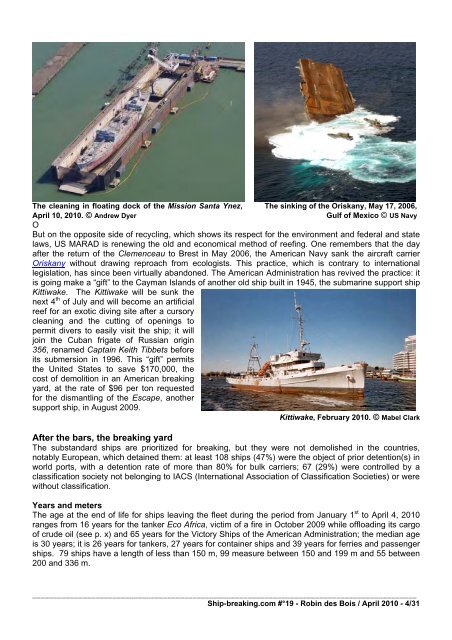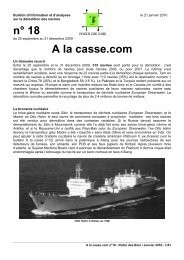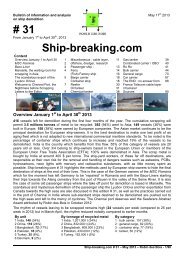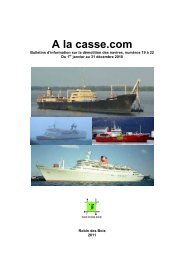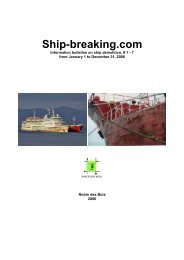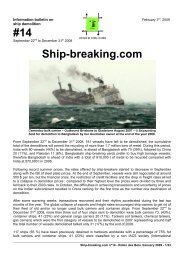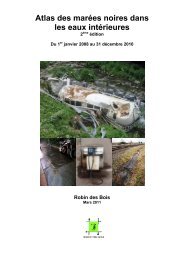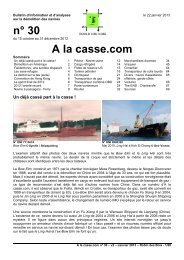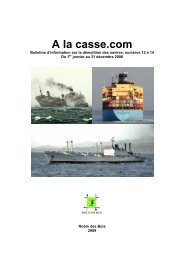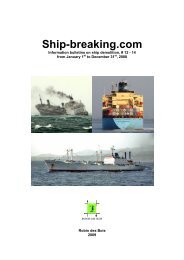Ship-breaking.com - Robin des Bois
Ship-breaking.com - Robin des Bois
Ship-breaking.com - Robin des Bois
You also want an ePaper? Increase the reach of your titles
YUMPU automatically turns print PDFs into web optimized ePapers that Google loves.
The cleaning in floating dock of the Mission Santa Ynez, The sinking of the Oriskany, May 17, 2006,<br />
April 10, 2010. © Andrew Dyer<br />
Gulf of Mexico © US Navy<br />
O<br />
But on the opposite side of recycling, which shows its respect for the environment and federal and state<br />
laws, US MARAD is renewing the old and economical method of reefing. One remembers that the day<br />
after the return of the Clemenceau to Brest in May 2006, the American Navy sank the aircraft carrier<br />
Oriskany without drawing reproach from ecologists. This practice, which is contrary to international<br />
legislation, has since been virtually abandoned. The American Administration has revived the practice: it<br />
is going make a “gift” to the Cayman Islands of another old ship built in 1945, the submarine support ship<br />
Kittiwake. The Kittiwake will be sunk the<br />
next 4 th of July and will be<strong>com</strong>e an artificial<br />
reef for an exotic diving site after a cursory<br />
cleaning and the cutting of openings to<br />
permit divers to easily visit the ship; it will<br />
join the Cuban frigate of Russian origin<br />
356, renamed Captain Keith Tibbets before<br />
its submersion in 1996. This “gift” permits<br />
the United States to save $170,000, the<br />
cost of demolition in an American <strong>breaking</strong><br />
yard, at the rate of $96 per ton requested<br />
for the dismantling of the Escape, another<br />
support ship, in August 2009.<br />
Kittiwake, February 2010. © Mabel Clark<br />
After the bars, the <strong>breaking</strong> yard<br />
The substandard ships are prioritized for <strong>breaking</strong>, but they were not demolished in the countries,<br />
notably European, which detained them: at least 108 ships (47%) were the object of prior detention(s) in<br />
world ports, with a detention rate of more than 80% for bulk carriers; 67 (29%) were controlled by a<br />
classification society not belonging to IACS (International Association of Classification Societies) or were<br />
without classification.<br />
Years and meters<br />
The age at the end of life for ships leaving the fleet during the period from January 1 st to April 4, 2010<br />
ranges from 16 years for the tanker Eco Africa, victim of a fire in October 2009 while offloading its cargo<br />
of crude oil (see p. x) and 65 years for the Victory <strong>Ship</strong>s of the American Administration; the median age<br />
is 30 years; it is 26 years for tankers, 27 years for container ships and 39 years for ferries and passenger<br />
ships. 79 ships have a length of less than 150 m, 99 measure between 150 and 199 m and 55 between<br />
200 and 336 m.<br />
___________________________________________________________________________________________<br />
<strong>Ship</strong>-<strong>breaking</strong>.<strong>com</strong> #°19 - <strong>Robin</strong> <strong>des</strong> <strong>Bois</strong> / April 2010 - 4/31


